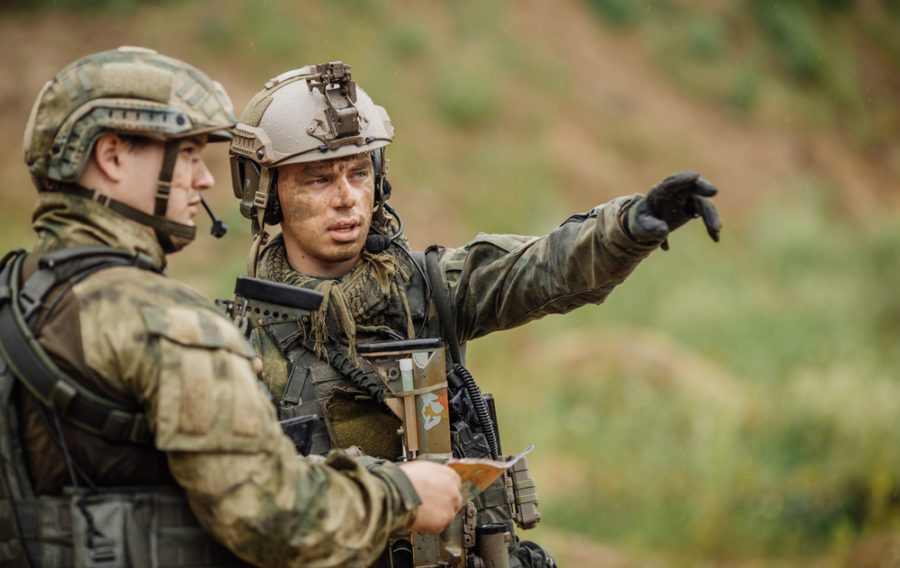
Writing for Defence Online, Tim Williams, Business Development Manager, QinetiQ, discusses battlefield communications and the need for increased investment to fully achieve the PACE method.
Command and Control (C2) communications are inherently complex, but also unavoidably essential, meaning in depth planning is always needed to establish them. And when implementing them in regions where the quality of network infrastructure is low, the task only increases in difficulty. This was particularly the case during the 80s and early 90s when technology was not as advanced and resourcing a comprehensive PACE (Primary, Alternate, Contingency, Emergency) plan was almost completely unachievable. Contingency communications were restricted to local infrastructure, such as a public telephone box (which were not always readily available) and there was a complete lack of emergency communications.
Whilst the digital revolution has resulted in more complex, data driven communication systems, teams are still hindered by an over reliance on Primary and Alternate plans. To deliver assured communications in operational theatres, steps must be taken to improve the quality of Contingency and Emergency systems for those on the battlefield.
How it worked in 1990s Bosnia
During my military career, I was deployed to Bosnia in the early 90s as part of the UN Protection Force. We were based in Sarajevo, where there was a need for area wide very high frequency (VHF) coverage to support the varying types of operations. To achieve this, it was estimated that three rebroadcast sites would need to be established. Generally, the higher up the rebroadcast station is, the better coverage it will provide. These types of installations typically also require both electrical power and physical security. Sarajevo is surrounded by mountains and many of them had friendly forces holding positions on top of them. We knew these forces could provide the necessary security and options for power, but we needed to confirm which of the available sites would provide the coverage required. Requiring us to visit and test from those locations.
Once we set off, we were isolated and at risk almost immediately as we were out of communications range of the HQ within minutes. To get to the first site required a four-hour drive, navigating crater filled roads, indiscriminate small arms fire and continuous faction checkpoints. Failing to reach the summit site within two hours from a physical check in site, would’ve meant HQ making a decision on whether to send out a search party. To put this in perspective, there is a ‘golden hour’ rule that is applied to the first hour after a serious injury has occurred, where prompt effective emergency care can mean a difference between surviving or not. If something happened to us on the route up to the top, it could have been three hours before anybody found us.
The impact of terrain on Primary resilience
Among the many things learned on this deployment, what became evidently clear was the impact of a terrain on primary communications. Consequently, after successfully installing one communication link back to HQ, upon entering into the next valley all communications ceased. This was the case in each valley, until entering Sarajevo again where the coverage improved. The process then began again as we headed to the second mountain site to install further range extension equipment. As can happen, technical faults can easily affect communications equipment, and maintenance requires regular trips between communication sites which could be two to three times a week. This would be mitigated by the availability of an Alternate system, had we had one.
The lack of suitable contingency systems in Bosnia compounded by the other challenges we faced during the tour demonstrate the difficulties and risk with setting up communications infrastructure in a war-torn country. Whilst every operational theatre presents its own unique challenges, from my experience, each suffered the same lack of assurance and minimal solutions to fall back on once the Primary and Alternate systems failed.
Today’s communications systems aren’t always fit for purpose
Disappointingly, whilst today’s Combat Net Radio systems are more digitised and more complex, they still often lack the versatility to deliver vital capability across the myriad of operational deployments.
Most of today’s Combat Net Radio systems were designed to support a formation (like a brigade or division) moving in battle. Rather than to support every type of operational scenario and certainly not the large percentage of operations that forces are deployed on today. The threat to security has changed significantly over the last 15 years driving a different approach, but very little has changed in how we communicate in the field. Although there is a need for this type of system to support general war or large scale campaigns, they are not the most common type of deployment. The most common tend to be smaller scale, where units are operating in remote areas without any communications infrastructure. Meaning, in essence, forces deploying on operations do so with suboptimal systems.
The Primary shortfall
The difficulty found with the slow progress to improve C2 infrastructure, is the continued reliance on Primary communications. When fully functional, this system provides operations staff with the tools they need to plan and prosecute the military tasks bestowed upon them. However, they will only provide limited coverage, in some cases covering just tens of miles away from base. This drives a need to install additional infrastructure to enable range extension – which adds further complexity. For example, if you require communications to support the deployment of troops to establish the lay of the land and de-risk future operational tasks in the theatre, you first need to deploy some sort of communications infrastructure. This scenario is based upon an environment where mobile phone networks are not functioning or use of them can create their own inherent security risk. In this case, the troops implementing an infrastructure do so at high risk and do not have supporting communications during the process until a network is established.
Finding the solution
As it takes many years to develop and bring a new core military Primary and Alternate system into service there will always be the challenge of evolving with the rate of development in technology. This means that it is difficult to develop communication capabilities to counter the new types of threats made possible by the advancement of technology. Change and adjustment of an existing system is expensive and slow. Further compounded by the 15-20 year life cycles of Primary and Alternate systems; by the time many systems are put into service they are already behind the power curve.
The challenge is to develop Primary and Alternate systems that remain versatile enough to counter the known threats of today and address the unknown threats yet to materialise, which is a utopian aim. Consequently, investment in the Contingency and Emergency areas should be increased. Growing the use of commercial solutions will allow for rapid development of systems which can use the most current technology and techniques. Although this approach could enhance the chances of achieving successful communication links in adverse conditions, it would require changes in policies, procedures in development and procurement and ultimately funding. However, this is balanced against assuring communications on the battlefield which will improve the safety and effectiveness of those tasked with defending their nations.
If you would like to join our community and read more articles like this then please click here







